National Archaeological Museum of Athens - Prehistoric Collection
The New York Times has recently (April 2008) published an article on Athens. In it there is a reference to the National Archaeological Museum of Athens: "In neighboring Exarcheia, the renovated National Archaeological Museum (Patission 44; 30-210-821-7724) has classical sculptures and gold treasures from Mycenae". We think of this reference as being the Understatement of the century! |
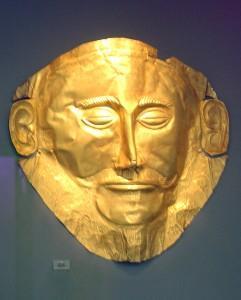 |
Athens National Archaeological Museum:
Exhibit 624. Gold death-mask, known as
the 'mask of Agamemnon'. (Grave V,
Grave Circle A, Mycenae, 16th century BC) |
This is because the Greek National Archaeological Museum in Athens is rightfully considered to be not only the most important, yet also one of the richest archaeological museums in the world in terms of containing Ancient Greek Art! Please refer to the relevant Album as proof of how much right we are!
The Greek National Archaeological Museum is housed in a neoclassical building designed by the noted German architect Ernst Ziller in 1889. It houses perhaps the most impressive collection of ancient Greek treasures in the world. The neoclassical design of the exterior tries its best to keep up with the true Greek classic style of the works it houses. This museum includes the golden so-called "Mask of Agamemnon", excavated by Heinrich Schliemann at ancient Mycenae, the bronze "boy jockey" of Artemision that somehow stayed in great condition despite being fished out of the sea, and a range of excellent sculptures, pottery, furniture and jewellery.
Further wonderful inclusions are:
- Prehistoric items/Ruins
- Sculpture
- Pottery and Minor art
- Bronzes
- Egyptian Art
Operating Hours are as follows:
Monday 13.00-19.30
Tuesday-Sunday 08.30-15.00
Telephone Contact: 210/821-7717 Address: 44, 28th Oktovriou (Patission) Ave, Athens, Greece |
Note: Given the huge number of exhibits, this album on the National Archaeological Museum of Athens is progressing step by step: Please visit this Album from time to time to see it growing!
(Photos: Michael Tziotis)
Select Page of the Album:
- The National Archaeological Museum of Athens: Why this Album?
- The National Archaeological Museum of Athens (The Building)
- Prehistoric Collection / Gallery IV / Mycenaean Civilization / Mycenae
- Gallery IV / Mycenaean Civilization / Mycenae / Grave Circle A / Finds from Graves I, II and VI, 16th century BC
- Gallery IV / Mycenaean Civilization / Mycenae / Grave Circle A / Finds from Grave III, 16th century BC (Window 1)
- Gallery IV / Mycenaean Civilization / Mycenae / Grave Circle A / Finds from Grave III, 16th century BC (Window 2)
- Gallery IV / Mycenaean Civilization / Mycenae / Grave Circle A / Finds from Grave IV, 16th century BC.
- Gallery IV / Mycenaean Civilization / Mycenae / Grave Circle A / Finds from Grave V, 16th century BC.
- Gallery IV / Mycenaean Civilization / Mycenae / Grave Circle A / Jewelry from Graves IV and V, 16th century BC.
- Gallery IV / Mycenaean Civilization / Mycenae / Grave Circle A / Gold and silver tableware from Graves IV and V, 16th century BC.
- Gallery IV / Mycenaean Civilization / Mycenae / Grave Circle A / Pottery vessels, 16th- early 15th century BC.
- Gallery IV / Mycenaean Civilization / Mycenae / Grave Circle A / Ritual vases-rhytons from Graves IV and V, 16th century BC.
- Gallery IV / Mycenaean Civilization / Mycenae / Grave Circle A / Exotic Objects, 16th century BC.
- Gallery IV / Mycenaean Civilization / Mycenae / Grave Circle A / Bronze vessels and tools from Graves III, IV and V, 16th century BC.
- Gallery IV / Mycenaean Civilization / Mycenae / Grave Circle A / Weapons and implements from Grave IV, 16th century BC.
- Gallery IV / Mycenaean Civilization / Mycenae / Grave Circle A / Weapons and implements from Grave V, 16th century BC.
- Gallery IV / Mycenaean Civilization / Mycenae / Grave Circle B / Finds from Graves Alpha, Zeta, Eta and Kappa, 17th-16th cent. BC
- Gallery IV / Mycenaean Civilization / Mycenae / Grave Circle B / Finds from the Male Inhumations in Grave Nu & the Female One in Grave Omicron, 17th-16th cent. BC
- Gallery IV / Mycenaean Civilization / Mycenae / Grave Circle B / Finds from Grave Gamma and Delta, 17th-16th cent. BC
- Gallery IV / Mycenaean Civilization / Mycenae / Grave Circle B / Finds from Graves Beta, Epsilon, Iota, Lamda, Mu, Xi, Upsilon, 16th century BC.
- Gallery IV / Mycenaean Civilization / Mycenae / Bone, Glass and Ivory Artifacts from the Mycenean Acropolis
- Gallery IV / Mycenaean Civilization / Mycenae / Palatial Workshops Finds and Bronze Weapon and Tool Hoards in the Acropolis of Mycenae, 14th-13th centuries BC
- Gallery IV / Mycenaean Civilization / Mycenae / Imported objects and raw materials from abroad, most found on the Mycenae acropolis.
- Gallery IV / Mycenaean Civilization / Mycenae / Clay and stone ritual vessels, used in religious ceremonies (15th-12th century BC).
- Gallery IV / Mycenaean Civilization / Mycenae / Pictorial Style pottery from the Mycenae acropolis.
- Gallery IV / Mycenaean Civilization / Mycenae / Wall-Paintings
- Gallery IV / Mycenaean Civilization / Tiryns/The Tiryns wall-paintings
- Gallery IV / Mycenaean Civilization / Tiryns/The Acropolis of Tiryns
Click on any of the pictures to enlarge.
Gallery IV / Mycenaean Civilization / Mycenae / Grave Circle A / Weapons and implements from Grave IV, 16th century BC.The Type A sword is considered to be a Minoan invention. Its appearance at Mycenae characterizes the first generation of kings there. Its use must have been customarily symbolic and ritual - a sign of authority for its noble owner. One of the most impressive swords of the Mycenaean world, it was nonetheless fragile because of the weak attachment of the handle onto the blade, and so it was quickly replaced by the more advanced Type B sword. Type B swords are shorter, stronger and more durable than their predecessors, and are regarded as a typical Mycenaean creation. Both of these sword types were designed to pierce the body.
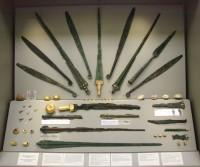
National Archaeological Museum: Gallery IV / Grave Circle A / Weapons and implements from Grave IV, Mycenae, 16th century BC. (General Photo of Window) |
|
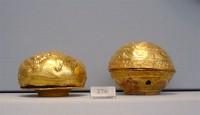
276. Sword pommels of gold. Tomb IV |
|
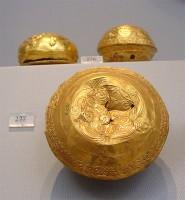
277. Sword pommel of gold. Tomb IV |
|
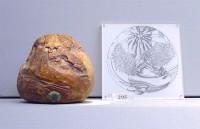
295. Ivory pommel with four running lions in relief . Tomb IV |
|
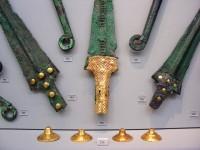
398, 407, 413, 435. Type B bronze swords. Some have gold revetment with linear motifs on the hilt and gold-plated nails. Tomb IV |
|
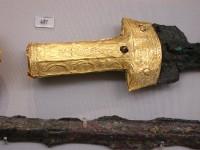
407. Detail of sword's handle Tomb IV |
|
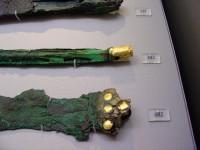
482, 403, 429. Bronze dagger with ivory revetment on the shoulder and gold-plated nails, fragment of a bronze staff with a gold ring at the hilt and a bronze knife. Tomb IV |
|
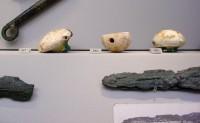
484, 487. Sword pommels of marble. |
|
Select Page of the Album:
- The National Archaeological Museum of Athens: Why this Album?
- The National Archaeological Museum of Athens (The Building)
- Prehistoric Collection / Gallery IV / Mycenaean Civilization / Mycenae
- Gallery IV / Mycenaean Civilization / Mycenae / Grave Circle A / Finds from Graves I, II and VI, 16th century BC
- Gallery IV / Mycenaean Civilization / Mycenae / Grave Circle A / Finds from Grave III, 16th century BC (Window 1)
- Gallery IV / Mycenaean Civilization / Mycenae / Grave Circle A / Finds from Grave III, 16th century BC (Window 2)
- Gallery IV / Mycenaean Civilization / Mycenae / Grave Circle A / Finds from Grave IV, 16th century BC.
- Gallery IV / Mycenaean Civilization / Mycenae / Grave Circle A / Finds from Grave V, 16th century BC.
- Gallery IV / Mycenaean Civilization / Mycenae / Grave Circle A / Jewelry from Graves IV and V, 16th century BC.
- Gallery IV / Mycenaean Civilization / Mycenae / Grave Circle A / Gold and silver tableware from Graves IV and V, 16th century BC.
- Gallery IV / Mycenaean Civilization / Mycenae / Grave Circle A / Pottery vessels, 16th- early 15th century BC.
- Gallery IV / Mycenaean Civilization / Mycenae / Grave Circle A / Ritual vases-rhytons from Graves IV and V, 16th century BC.
- Gallery IV / Mycenaean Civilization / Mycenae / Grave Circle A / Exotic Objects, 16th century BC.
- Gallery IV / Mycenaean Civilization / Mycenae / Grave Circle A / Bronze vessels and tools from Graves III, IV and V, 16th century BC.
- Gallery IV / Mycenaean Civilization / Mycenae / Grave Circle A / Weapons and implements from Grave IV, 16th century BC.
- Gallery IV / Mycenaean Civilization / Mycenae / Grave Circle A / Weapons and implements from Grave V, 16th century BC.
- Gallery IV / Mycenaean Civilization / Mycenae / Grave Circle B / Finds from Graves Alpha, Zeta, Eta and Kappa, 17th-16th cent. BC
- Gallery IV / Mycenaean Civilization / Mycenae / Grave Circle B / Finds from the Male Inhumations in Grave Nu & the Female One in Grave Omicron, 17th-16th cent. BC
- Gallery IV / Mycenaean Civilization / Mycenae / Grave Circle B / Finds from Grave Gamma and Delta, 17th-16th cent. BC
- Gallery IV / Mycenaean Civilization / Mycenae / Grave Circle B / Finds from Graves Beta, Epsilon, Iota, Lamda, Mu, Xi, Upsilon, 16th century BC.
- Gallery IV / Mycenaean Civilization / Mycenae / Bone, Glass and Ivory Artifacts from the Mycenean Acropolis
- Gallery IV / Mycenaean Civilization / Mycenae / Palatial Workshops Finds and Bronze Weapon and Tool Hoards in the Acropolis of Mycenae, 14th-13th centuries BC
- Gallery IV / Mycenaean Civilization / Mycenae / Imported objects and raw materials from abroad, most found on the Mycenae acropolis.
- Gallery IV / Mycenaean Civilization / Mycenae / Clay and stone ritual vessels, used in religious ceremonies (15th-12th century BC).
- Gallery IV / Mycenaean Civilization / Mycenae / Pictorial Style pottery from the Mycenae acropolis.
- Gallery IV / Mycenaean Civilization / Mycenae / Wall-Paintings
- Gallery IV / Mycenaean Civilization / Tiryns/The Tiryns wall-paintings
- Gallery IV / Mycenaean Civilization / Tiryns/The Acropolis of Tiryns
|
|



